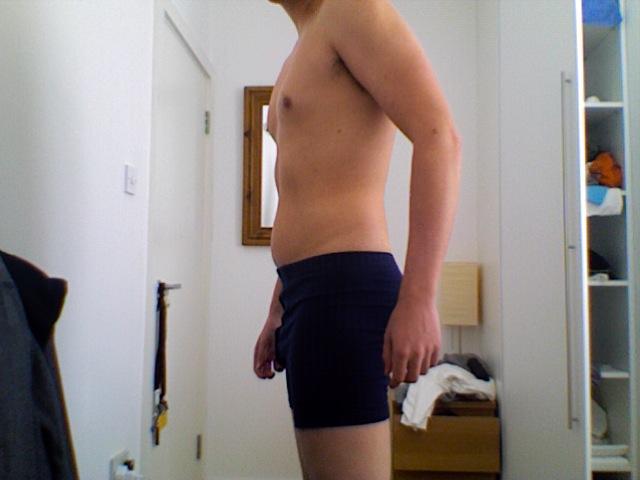
This is the complete guide to going from skinny fat to lean.
Specifically, you will learn:
- What the skinny fat body type is
- How to eat to get lean
- Mistakes to avoid
- How to train
Ready? Let’s dive in.
More...
Fix the skinny fat look in 7 simple steps...
Download my free guide on fixing the skinny fat look in the next 6 months. Implement step one today!
What is Skinny Fat, and Why Do People End Up With This Body Type?
The skinny fat body type is characterized by a high body fat percentage and low muscular development. Skinny fat folks appear thin and fit while wearing clothes but lack muscle definition and look out of shape when shirtless.
A skinny fat person will often carry more fat in troublesome areas:
- Men - chest, stomach, and lower back
- Women - belly, lower back, buttocks, and thighs
Here are a couple of photos showing what a skinny fat man and woman might look like:


One common reason for ending up skinny fat is improper weight loss. Many overweight people focus on crash dieting in combination with too much cardio. As a result, they lose weight quickly, but a lot of it ends up being muscle.
The approach is why I ended up skinny fat when I first lost weight at the start of my fitness journey:

How to Go From Skinny Fat to Lean In 5 Steps
1. Calculate Your Calorie Needs
The first step to going from skinny fat to lean is to establish a calorie deficit, which leads to fat loss (1). But, to do that, you must first know how many calories you should eat.
One option for calculating your calories is to use an online calculator. Plug in your basic information, and the tool will estimate how many calories you’re burning daily.
Alternatively, use the following formula and multiplier:
Women
BMR = 655 + (4.35 x weight in pounds) + (4.7 x height in inches) - (4.7 x age in years)
BMR = 655 + (9.6 x weight in kg) + (1.8 x height in cm) - (4.7 x age in years)
Men
BMR = 66 + (6.23 x weight in pounds) + (12.7 x height in inches) - (6.8 x age in years)
BMR = 66 + (13.7 x weight in kg) + (5 x height in cm) - (6.8 x age in years)
(Source.)
Once you have your BMR value (the number of calories you burn at rest), it’s time to multiply by one of the following:
- Sedentary (little or no exercise): Calorie-Calculation = BMR x 1.2
- Lightly active (light exercise/sports 1-3 days/week): Calorie-Calculation = BMR x 1.375
- Moderately active (moderate exercise/sports 3-5 days/week): Calorie-Calculation = BMR x 1.55
- Very active (hard exercise/sports 6-7 days a week): Calorie-Calculation = BMR x 1.725
- Extra active (very hard exercise/sports & physical job or 2x training): Calorie-Calculation = BMR x 1.9
(Source.)
Be honest here.
You will end up with a rough estimation of your daily calorie expenditure. Since going from skinny fat to lean requires fat loss, you should then remove some calories to create a deficit.
For example, let’s say that your TDEE is 2,500 calories. Removing 500 calories and eating 2,000 daily would put you on track to lose fat.
2. Determine Your Macronutrient Intake
The next step to going from skinny fat to lean is to determine your diet composition by calculating your macronutrient intake.
One option is to only track your protein, given the nutrient’s importance for recovery, health, and muscle maintenance during a diet (2, 3). In that case, simply focus on getting 0.8 to 1 gram of protein per pound of body weight (3). For example, if you weigh 170 lbs, aim for 136 to 170 grams of protein daily.
Alternatively, follow these recommendations to determine your macronutrient intake:
- 0.8 to 1 gram of protein per lb of body weight
- 0.35 to 0.45 grams of fats per lb of body weight
- Remaining calories from carbohydrates
So long as you cover your daily protein and fat needs, your carb intake will sort itself out.
3. Weigh Your Food
Once you’ve determined your daily nutritional targets, it’s time to start weighing your food with a simple kitchen scale. The process isn’t challenging but can be tedious when first getting started.
Weighing your food is necessary for ensuring nutritional accuracy and building skills that will help you control your food intake for life:
- Eyeballing food amounts
- Estimating how many calories are in a meal
- Learning to track hidden calories: oils, condiments, drinks, etc.
- Understanding how much food you need for specific goals (muscle gain, fat loss, etc.)
4. Start Logging Your Calorie Intake
Okay, you’ve set up your diet, you have a kitchen scale, and you’ve started weighing your food before eating. But how do you tie it all up? By logging your calorie intake.
Download a simple app like MyFitnessPal or get a notebook and start writing down the foods you’re eating and their respective quantities.
Using an app is easier because it calculates your calories and macronutrients. In contrast, writing down your foods requires manual calculations each time, which can get tedious.
5. Lift Weights
The final thing you need to go from skinny fat to lean is to do some resistance training.
Lifting weights is necessary because it provides a strong stimulus that helps you build muscle and maintain it while dieting (4). As a result, you can lose primarily fat and achieve a lean and athletic physique more easily.
The exact form of weight training isn’t that important. You can do kettlebell workouts, bodyweight exercises, traditional gym training, and more. Focus on the following:
- Hit the gym three to four times per week
- Train each muscle group twice per week (5)
- Do at least 12 to 16 sets for large muscle groups (chest, back, and quads); and 6 to 10 for smaller ones (biceps, triceps, shoulders, and calves)
- Train within your limits by leaving one to three reps in the tank on most sets (6)
- Progressively increase the amount of work you’re doing (sets, reps, weight lifted, etc.)
- Maintain proper form and do each exercise through a full range of motion
The Mistakes Skinny Fat People Make When Trying to Get Lean
1. Looking For Instant Gratification
A common mistake skinny fat people make when trying to get lean is looking for a shortcut.
One notable example is relying on serious procedures like liposuction to get lean. The problem with such approaches is that you only get temporary results. Plus, the results aren’t great, and you don’t develop the habits you need to maintain your results afterward.
2. Not Doing Resistance Exercise
Another common mistake is not doing resistance training, which prevents you from holding onto muscle and going from skinny fat to lean.
As discussed, the precise form of resistance exercise doesn’t matter. Calisthenics, CrossFit, and even bodyweight exercises at home can be effective.
3. Doing too Much Cardio
Some cardio can be useful for improving your health, which is particularly important for skinny fat individuals.
The problem is that solely relying on cardio and doing too much leads to muscle loss and prevents your skinny fat to lean transformation.
Avoid the error by focusing on resistance training and including a bit of cardio on recovery days or after you finish your workouts. Here is an article on the topic and some practical ideas for doing cardio as a skinny fat person.
4. Not Moving Much During the Day
Following a structured exercise program is a great first step to going from skinny fat to lean and reducing the risk of health issues down the road. But just because you’re active for 60, 120, or 180 minutes per week doesn’t mean you should be sedentary.
Moving more during the day is an excellent way to increase your g-flux, which offers health and fitness benefits. Here’s a guide on g-flux and its role in going from skinny fat to lean.
The Bottom Line
Going from skinny fat to lean isn’t complicated, but the process requires patience, discipline, and consistency.
I hope this guide provides clarity and makes it easier to get started. Check out the box below to get a full step-by-step guide on fixing the skinny fat physique in the next six months:
Fix the skinny fat look in 7 simple steps...
Download my free guide on fixing the skinny fat look in the next 6 months. Implement step one today!
1. Strasser B, Spreitzer A, Haber P. Fat loss depends on energy deficit only, independently of the method for weight loss. Ann Nutr Metab. 2007;51(5):428-32. doi: 10.1159/000111162. Epub 2007 Nov 20. PMID: 18025815.
2. Wu G. Dietary protein intake and human health. Food Funct. 2016 Mar;7(3):1251-65. doi: 10.1039/c5fo01530h. PMID: 26797090.
3. Stokes T, Hector AJ, Morton RW, McGlory C, Phillips SM. Recent Perspectives Regarding the Role of Dietary Protein for the Promotion of Muscle Hypertrophy with Resistance Exercise Training. Nutrients. 2018 Feb 7;10(2):180. doi: 10.3390/nu10020180. PMID: 29414855; PMCID: PMC5852756.
4. Schoenfeld BJ, Contreras B, Krieger J, Grgic J, Delcastillo K, Belliard R, Alto A. Resistance Training Volume Enhances Muscle Hypertrophy but Not Strength in Trained Men. Med Sci Sports Exerc. 2019 Jan;51(1):94-103. doi: 10.1249/MSS.0000000000001764. PMID: 30153194; PMCID: PMC6303131.
5. Schoenfeld BJ, Ogborn D, Krieger JW. Effects of Resistance Training Frequency on Measures of Muscle Hypertrophy: A Systematic Review and Meta-Analysis. Sports Med. 2016 Nov;46(11):1689-1697. doi: 10.1007/s40279-016-0543-8. PMID: 27102172.
6. Santanielo N, Nóbrega SR, Scarpelli MC, Alvarez IF, Otoboni GB, Pintanel L, Libardi CA. Effect of resistance training to muscle failure vs non-failure on strength, hypertrophy and muscle architecture in trained individuals. Biol Sport. 2020 Dec;37(4):333-341. doi: 10.5114/biolsport.2020.96317. Epub 2020 Jul 5. PMID: 33343066; PMCID: PMC7725035.
Leave a Reply